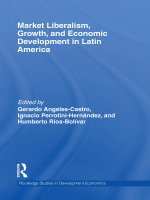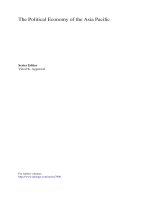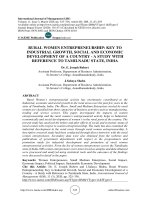Economic growth and economic development 351
Bạn đang xem bản rút gọn của tài liệu. Xem và tải ngay bản đầy đủ của tài liệu tại đây (170.73 KB, 1 trang )
Introduction to Modern Economic Growth
xˆ (t) satisfy (7.34)-(7.36). Suppose also that for the resulting costate variable λ (t),
x (t) − x˜ (t)) ≤
H (t, x, y, λ) is jointly concave in (x, y) for all t ∈ R+ and that limt→∞ λ (t) (ˆ
0 for all x˜ (t) implied by an admissible control path y˜ (t), then yˆ (t) and the corresponding xˆ (t) achieve the unique global maximum of (7.28).
Theorem 7.12. (Arrow Sufficient Conditions for Infinite Horizon)
Consider the problem of maximizing (7.28) subject to (7.29) and (7.30), with f and
g continuously differentiable. Define H (t, x, y, λ) as in (7.12), and suppose that a
piecewise continuous solution yˆ (t) and the corresponding path of state variable xˆ (t)
satisfy (7.34)-(7.36). Given the resulting costate variable λ (t), define M (t, x, λ) ≡
x (t) − x˜ (t)) ≤ 0
H (t, x, yˆ (t) , λ). If M (t, x, λ) is concave in x and limt→∞ λ (t) (ˆ
for all x˜ (t) implied by an admissible control path y˜ (t), then the pair (ˆ
x (t) , yˆ (t))
achieves the unique global maximum of (7.28).
The proofs of both of these theorems are similar to that of Theorem 7.5 and are
left for the reader (See Exercise 7.11).
Notice that both of these sufficiency theorems involve the difficult to check condi-
tion that limt→∞ λ (t) (x (t) − x˜ (t)) ≤ 0 for all x˜ (t) implied by an admissible control
path y˜ (t). This condition will disappear when we can impose a proper transversality
condition.
7.3.2. Economic Intuition. The Maximum Principle is not only a powerful
mathematical tool, but from an economic point of view, it is the right tool, because
it captures the essential economic intuition of dynamic economic problems. In this
subsection, we provide two different and complementary economic intuitions for the
Maximum Principle. One of them is based on the original form as stated in Theorem
7.3 or Theorem 7.9, while the other is based on the dynamic programming (HJB)
version provided in Theorem 7.10.
To obtain the first intuition consider the problem of maximizing
(7.40)
Z t1
0
H (t, xˆ (t) , y (t) , λ (t)) dt =
Z
t1
[f (t, xˆ (t) , y (t)) + λ (t) g (t, xˆ (t) , y (t))] dt
0
with respect to the entire function y (t) for given λ (t) and xˆ (t), where t1 can
be finite or equal to +∞. The condition Hy (t, xˆ (t) , y (t) , λ (t)) = 0 would then
337









